
Monroe Township is one of thirteen townships in Putnam County, Indiana. As of the 2020 census, its population was 1,494 and it contained 634 housing units.

The Lane Place was the home of Sen. Henry S. Lane and Joanna Lane (1826-1914). It is located at 212 South Water Street in Crawfordsville, Indiana. Helen Elston Smith, the Lanes' niece, inherited the house after Joanna's death. She willed the house and its contents to the Montgomery County Historical Society on February 26, 1931. 85%-90% of all of the furnishings are either original to the house or belonged to the Elston Family. The house has been a museum since 1931 even though Helen continued to live in the home until the mid-1930s.

The Maj. Isaac C. Elston House, also known as Elston Homestead, is a historic home located at Crawfordsville, Montgomery County, Indiana, United States. It was the home of Maj. Isaac Compton Elston, who fought in the War of 1812 and the Black Hawk War. When he was 39, he moved to Indiana and became a frontier merchant, banker and financier. The Home was given to Wabash College by his grandson, Isaac Compton Elston, Jr. (1873-1964) and is now used as the President's home.
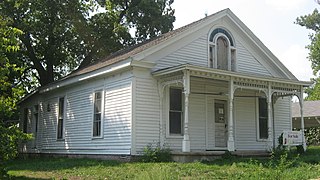
T.C. Steele Boyhood Home, also known as the T.C. Steele House, is a historic home located at Waveland, Montgomery County, Indiana. It was built about 1852, and is a 1+1⁄2-story, three-bay, Greek Revival style frame dwelling with a front-gable roof. The house was renovated and enlarged between 1895 and 1902. It was partially restored in 2002. Restoration was completed in 2014 and the home now operates as a privately owned, no cost retreat for artists and historic preservationists. It was the boyhood home of noted Indiana impressionist artist T.C. Steele (1847-1926).

McClelland-Layne House is a historic home located at Crawfordsville, Montgomery County, Indiana. It was built in 1869, and is a two-story, L-shaped, Italian Villa style brick dwelling. It has a low-hipped roof and segmental- and round-arched windows. The house features a three-story tower topped by a low-hipped roof. It was built for well known Crawfordsville surgeon Dr. James S. McClelland.
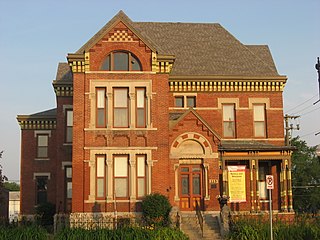
Montgomery County Jail and Sheriff's Residence is a historic jail and sheriff's residence located at Crawfordsville, Montgomery County, Indiana. It was built in 1882 in two sections, and is a 2+1⁄2-story, red brick and limestone building in a combination of Italianate, Gothic Revival, and Romanesque Revival style architecture. The jail is a rotary jail; it is the only example of this type in Indiana and one of two left in the United States. The building houses a local history and prison museum.
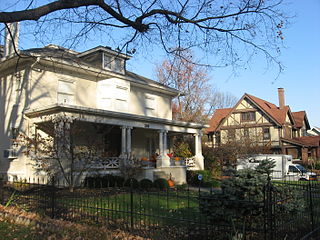
Elston Grove Historic District is a national historic district located at Crawfordsville, Montgomery County, Indiana. The district encompasses 138 contributing buildings and 8 contributing structures in a predominantly residential section of Crawfordsville. It developed between about 1835 and 1935, and includes notable examples of Italianate, Queen Anne, and Colonial Revival style architecture. Located in the district are the separately listed Col. Isaac C. Elston House, Henry S. Lane House, and Gen. Lew Wallace Study. Other notable buildings include the Galey House (1848), Campbell House (1852), T.S. Scott House, Powers House (1862), Blair House, Hadley and Hornaday Houses (1878), Alfrey House (1885), Detchon House, Ashley House, Snyder House, and Voris House.
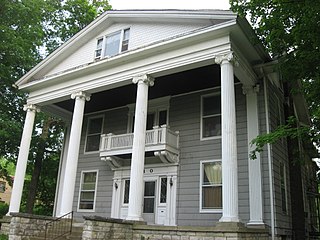
Eastern Enlargement Historic District is a national historic district located at Greencastle, Putnam County, Indiana. The district encompasses 272 contributing buildings in a predominantly residential section of Greencastle. The district developed between about 1840 and 1961 and includes notable examples of Greek Revival, Gothic Revival, Italianate, Queen Anne, Stick Style, and Bungalow / American Craftsman style architecture. Located in the district are the separately listed Delta Kappa Epsilon Fraternity House, F.P. Nelson House and William C. Van Arsdel House. Other notable buildings include the Braman House (1840), James B. Nelson House, O'Hair House, John Ireland House, and a number of fraternity and sorority houses associated with DePauw University.
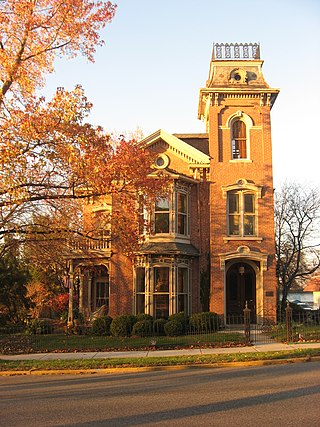
James H. Ward House is a historic home located at Lafayette, Indiana, United States. It was built about 1875, and is a two-story Italianate / Second Empire style brick dwelling, with a 3+1⁄2-story mansard roofed tower. It features deep overhanging eaves with corner brackets, asymmetrical massing, and an ornate semi-hexagonal, two-story projecting bay. Also on the property is a contributing carriage house.

Perrin Historic District is a national historic district located at Lafayette, Tippecanoe County, Indiana. The district encompasses 173 contributing buildings and 2 contributing structures in a predominantly residential section of Lafayette. It developed between about 1869 and 1923 and includes representative examples of Italianate, Queen Anne, Colonial Revival, Stick Style / Eastlake movement, and Bungalow / American Craftsman style architecture. Notable contributing buildings include the James Perrin House, John Heinmiller House, James H. Cable House, Adam Herzog House (1878), Coleman-Gude House (1875), Frank Bernhardt House (1873), August Fisher Cottage, John Beck House (1887), an William H. Sarles Bungalow (1923).

Conklin-Montgomery House is a historic home located at Cambridge City, Wayne County, Indiana. It was built between about 1836 and 1838, and is a two-story, five-bay, brick hip and end gable roofed townhouse. It features a two-story, in antis, recessed portico with a second story balcony supported by Ionic order and Doric order columns. Also on the property is a contributing pre-American Civil War gazebo.

Cambridge City Historic District is a national historic district located at Cambridge City, Wayne County, Indiana. The district encompasses 572 contributing buildings and 2 contributing structures in the central business district and surrounding residential sections of Cambridge City. It developed between about 1838 and 1939 and includes representative examples of Greek Revival, Italianate, and Federal style architecture. Located in the district are the separately listed Conklin-Montgomery House and Lackey-Overbeck House. Other notable contributing buildings include the Vinton House (1849), Opera House (1876), Western Wayne Bank, Grand Theater, Knights of Pythias Building (1899), Public Library (1936), U.S. Post Office (1940), City Building (1901), Crum-Swiggett House, Old Bertsch Foundry (1853), Presbyterian Church (1858), St. Elizabeth's Roman Catholic Church (1880), and Central School (1935).

Christopher Apple House, also known as the Apple Farm House, is a historic home located in Lawrence Township, Marion County, Indiana. It was built in 1859, and is a two-story, four bay Federal style brick dwelling with Greek Revival style design elements. It has a side gable roof and 1+1⁄2-story rear wing.

Cotton–Ropkey House, also known as the Ropkey House, is a historic home located at Indianapolis, Marion County, Indiana. It was built about 1850, and is a two-story, three-bay-by-four-bay, transitional Italianate / Greek Revival style timber frame dwelling. It has a hipped roof and is sheathed in clapboard siding.

Allison Mansion, also known as Riverdale, is a historic home located on the campus of Marian University at Indianapolis, Marion County, Indiana. It was built between 1911 and 1914, and is a large two-story, Arts and Crafts style red brick mansion with a red tile roof. The house features a sunken conservatory, porte cochere, and sunken white marble aviary.

Prosser House is a historic home located at Indianapolis, Indiana. It was built about 1885, and is a small 1+1⁄2-story, stuccoed frame dwelling with applied decoration in cast concrete. It has a cross-gable roof with five dormers. The interior features elaborate plaster work.
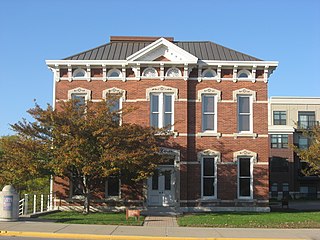
Charles Kuhn House is a historic home located at Indianapolis, Indiana. It was built about 1879, and is a two-story, five-bay, Italianate style brick dwelling. It has a hipped roof with pressed metal brackets and a centered gable.

John Fitch Hill House is a historic home located at Indianapolis, Indiana. It was built about 1852, and is a two-story, five-bay, Italianate style frame dwelling. It has a low hipped roof with double brackets and a centered gable. It features a full-width front porch added in the 1880s.

Old Indianapolis City Hall, formerly known as the Indiana State Museum, is a historic city hall located at Indianapolis, Indiana. It was built in 1909–1910, and is a four-story, Classical Revival style brick building sheathed in Indiana limestone. It measures 188 by 133 feet.

Shortridge–Meridian Street Apartments Historic District is a national historic district located at Indianapolis, Indiana. The district encompasses 136 contributing buildings in a predominantly residential section of Indianapolis. It was developed between about 1900 and 1951, and includes representative examples of Colonial Revival, Classical Revival, Late Gothic Revival, Mission Revival, Renaissance Revival, Bungalow / American Craftsman, and Art Deco style architecture. Located in the district is the separately listed Shortridge High School. Other notable buildings include the Vernon Court Apartments (1928), Fronenac Apartments (1951), Biltmore Apartments (1927), Meridian Apartments (1929), New Yorker Apartments (1917), Howland Manor (1929), Powell-Evans House (1911), Harms House (1906), Dorchester Apartments (1921), and Martin Manor Apartments (1916).
























